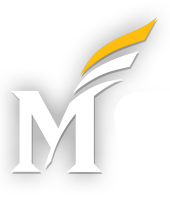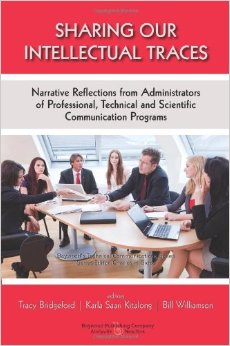By Caitlin Dungan
Caitlin Dungan is a PhD student in Mason’s Writing and Rhetoric PhD Program. Caitlin is a Graduate Research Assistant for Mason’s Writing Across the Curriculum Program, and her current research interests include fanfiction, digital media and rhetoric, online feedback practices, and participatory culture.
Sharing our Intellectual Traces: Narrative Reflections from Administrators of Professional, Technical and Scientific Communication Programs, eds. Tracy Bridgeford, Karla Saari Kitalong, Bill Williamson (Amityville, NY: Baywood Publishing, 2014).
Sharing our Intellectual Traces walks a mediatory line between the worlds of technical and professional communication, pedagogy, writing program administration, and writing across the curriculum. Though it may seem difficult to weave these related yet disparate areas together, the unique lenses through which this collection views these fields – narrative and administration – are the key to the success of its message and to its utility. The narrative nature of this collection offers perspectives about complicated institutional dynamics in a manner that is relatable and illuminating.
The larger intent of these reflections is to serve as a starting point for further conversation for technical and professional communication programs. As Kirk St. Amant notes in the Introduction, “Such narratives provide a rich set of experiences others can use as heuristics for contextualizing their own experiences or as approaches for addressing a wide range of events. Moreover, when collected in one place, this aggregation of narratives can serve as a critical resource and reference for other members of the field” (vii). For the most part, the chapters are focused primarily on pedagogical implications and consequently are a valuable resource not only for program directors but also for teachers looking to inform their technical communication pedagogy. Though the focus is on technical and professional writing programs, the takeaways of each chapter are easily adaptable to any aspect of the teaching of writing.
The phrase “It’s not news that…” is repeated throughout this collection, and its repetition reinforces an important point: while some of what is discussed is not particularly new to administrators, it is crucial to articulate the overarching goals and purposes of writing programs in print. In their comprehensive discussion of the problems facing technical and professional communications programs, former CPTSC past presidents, including Deborah Andrews, Stephen A. Bernhardt, Kelli Cargile Cook, Jeff Grabill, Bruch Maylath, Dan Riordan, and Stuart A. Selber, note that sometimes even the basic foundations of the field are overlooked and must be re-addressed, especially in a discipline that advances and outgrows itself as quickly as technical communication does (Chapter 2, “Tracing the Intellectual Trajectories of Professional/Technical/Scientific Communication: A Roundtable Perspective from Seven CPTSC Past Presidents”). As a result, Andrews et al. point out that certain problems associated with administration eventually become cyclical. Technologies and rhetorics surrounding practical, professional, and pedagogical spheres continue to develop and demand self-reflexive evaluation. This process of reevaluation is precisely what the collection offers as a way for administrators to sustain and grow their programs without stagnation.
The majority of the chapters in Sharing address the idea that technical and professional rhetoric programs are designed – be it purposefully or recursively – to best support the user. In the more pedagogically focused chapters, the “users” are defined as the students of the program. As Andrews et al. argue, “Technology can be a physical artifact, but it can also be a process, procedure, or system […]” (17), technical communication WPAs should, therefore, “work backwards from the job market, for instance, identifying skillsets that students need as workplace practitioners and then designing institutional infrastructures for developing those skills” (19). Chapters 3, 4, 7 and 9 address how best to fulfill these needs at different institutions. Sometimes, such as at the University of Colorado, Colorado Springs (Chapter 4, “Establishing an Outcomes Statement for Technical Communication” by K. Alex Illyasova and Tracy Bridgeford), a focus on students becomes a focus on serving a larger community. Students entered the technical communication program at UCCS to serve the same working community from which they had come. By extension, the outcomes statement of the program reflects the practical needs of its students instead of the “general theories garnered from scholarly articles, hallway conversations, or conference discussions” (58). For other institutions, such as at Michigan Technological University, the “user” comes from different departments across the university, as M. Ann Brady and Karla Saari Kitalong note (Chapter 9, “Users, Not Solutions, First: Problem-Solving for Program Administrators”). Regardless of discipline, students and faculty all must come together for the same purpose: to utilize technology as a writing tool. Brady and Kitalong explain that at MTU, problems arose when the Center for Computer-Assisted Language Instruction at Michigan Tech began to stagnate after original administrators Cynthia and Richard Selfe retired. Critical conversations took another two decades to occur, and only then did faculty ask: Who are the users of the CCLI and what do they need from this center? Both Illyasova and Bridgeford’s work as well as Brady and Kitalong’s examples are situated in specifics; however, like all of the chapters of this collection, key questions can be extrapolated and applied to any discipline and any institution. Who are the users of a program? What problems are they facing? What are their needs, and how can a program, classroom, or institution be rethought to best service them? With these considerations of students-as-users in mind, usability is not a term that operates solely within technical communication practice.
Collaborative leadership also shapes discussions of writing program administration in Sharing. Pavel Zemliansky relates his experiences founding the Writing Across the Curriculum Program at the University of Central Florida (Chapter 11, “Expertise in Professional Communication as a Catalyst of WAC/WIC Administration Success”). Zemliansky suggests that what may initially seem to be a failure – he relates an experience in which only 2 faculty members attended a professional development workshop – can lead to great opportunities for program growth. The 2 faculty members who attended Zemliansky’s workshop helped start a dialogue about the importance of writing in the disciplines, and thereby initiated a wider conversation about the ways WAC can help programs outside of English. Similarly, Julie Dyke Ford discusses her movement from a technical writing program into mechanical engineering, as well as the challenges she faced implementing a writing curriculum in the disciplines. She observes that liberal arts courses often seem “touchy-feely” to those in the hard sciences (151), but when repackaged with the “user” in mind, engineering faculty became much more open to conversations about curriculum development at both an undergraduate and graduate level. Along these lines, Meg Morgan argues that “transformational leadership” rather than “transactional leadership” helps administrators to forge strategic partnerships to expand offerings in writing curriculum (Chapter 6, “Leaders Becoming Transformed”). Morgan relates her experiences as a WPA of a technical communication program at UNC-Charlotte, and she finds that a leader’s willingness to distribute power among many participants leads to a greater sense of community and investment in the long-term goals of a program. Zemliansky’s, Morgan’s, and Ford’s experiences illustrate the critical importance of interdepartmental collaboration in the growth and long-term success of writing programs.
One drawback of this collection is that one of the most critical conversations – the concept of globalization, its effects on the larger job and industrial markets, and, consequently, technical and professional writing programs seeking to support their students – is given a single chapter. Laurence José complicates the use of the term “globalization” across technical communication (Chapter 8, “Globalizing Technical Communication Programs: A Diachronic Perspective”). José contends that programs have started to utilize “globalization” as a buzzword in their curriculum – a consequence of recursive program development that reflects its casual use in industry. He warns against using “globalization” to market curriculum or research without substance behind it, as well as articulates the consequences of deploying the word in technical and professional communication programs. The lack of discussion on globalization elsewhere in this collection ironically reinforces José’s concern, and that lack serves as a call for a similarly structured, narrative-driven book with globalization and its effects on professional, technical, and scientific communication programs at its core.
Ultimately, the strengths of this collection are its readability and flexibility, as well as the ease by which its suggestions can be implemented across disciplines, programs, and institutions. The narrative format makes the chapters of this collection quick to read and easy to comprehend. Though many of the chapters employ complex theories to contextualize their stories, the application of the theory remains light and informative. Some of the chapters also include helpful appendices, such as Chapter 4 and Chapter 12 (“Curricular Challenges of Emphasis Degrees in Technical and Professional Communication,” Lisa Meloncon). One of the unique aspects of this collection is the focus not only on four-year institutions, but on the implications for two-year programs and vocational schools as well. Altogether, this collection certainly fulfills its primary objective: to see different problems in technical and professional program administration through a narrative lens.

